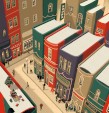Forget digital versus print for a moment, and consider a cookbook's format. Think back to the last time you used a cookbook in the kitchen. Was the book covered in a dust jacket? A cumbersome, flappy dust jacket? If it wasn’t, was that because you had ripped it off? Or were you cooking from an unjacketed hardcover?
The format known as paper-over-board—in which a hardcover book has a photograph printed directly on its front cover and no dust jacket—has taken the cookbook world by storm lately, simultaneously infusing cookbooks with old-world charm and a modern feel. Some of this season's most interesting cookbooks, from Andrea Reusing's Cooking in the Moment (Clarkson Potter) to Mark Scarbrough and Bruce Weinstein's Goat (Stewart, Tabori, and Chang) are paper-over-board, A paper-over-board book looks at once refined and useful. It seems more “design-y” than a simple hardcover with a dust jacket, suggesting that careful thought and consideration have gone into a book’s look and feel. “Honestly, it just feels good in your hands,” says Lynne McAdoo, v-p of sales (books) at Andrews McMeel.
McAdoo explained the reasoning behind Andrews McMeel’s decision to publish Vegan Family Meals: Real Food for Everyone by Ann Gentry, out this summer, as a paper-over-board book. “The POB format allows for more creativity in cover design and materials,” she said. “We get to experiment with texture and create a more tactile experience for the reader. And a lot of home cooks remove the jacket anyway, so we think they’re going to especially like this format. We want to create a terrific package that is hardworking yet is beautiful and a keepsake.”
Cassie Jones, editorial director of William Morrow Cookbooks, said the format can work well on books aimed at certain demographics: “Paper over board can give books a younger, fresher feel.” On May 3, Morrow will release Guy Fieri Food: More Than 150 Off the Hook Recipes by TV star Fieri, a paper-over-board hardcover, and this fall it will apply the format to The Treats Truck Baking Book, featuring recipes from one of New York City’s popular food trucks.
Aaron Wehner, publisher of Ten Speed Press, echoed McAdoo’s “it just feels good in your hands” comment, noting, “To me it’s a subjective feel thing—a jacket can sometimes seem a little formal and traditional for a particular book,” while paper-over-board “can feel more contemporary, and a little less fussy.” Wehner said the format works on certain books; for Ten Speed, those books range from this season’s The Sriracha Cookbook by Randy Clemens to summer’s Tender by Nigel Slater and Paletas by Fany Gerson, to titles on the house’s fall list, including Bitters by Brad Parsons and Rustic Italian Food by Marc Vetri.
Hearst Books, an imprint of Sterling, has had success with its paper-over-board hidden spiral format, which lets books lie flat--an attractive attribute for home cooks. Another reason for the format's popularity: it can also help a book stand out in a crowded field, which is the case for Ghillie James's Jam, Jelly & Relish: Simple Preserves, Pickles & Chutneys & Creative Ways to Cook with Them, which Kyle Books will release in August. So many books on the subject of canning and preserving have been published in recent years, and perhaps a different look will help Jam, Jelly & Radish garner some attention.
Generally speaking the format does not cost any more or less to produce. But there can be some minor drawbacks: if a retailer returns any books and they are damaged (which can happen without that protective dust jacket), the publisher can’t simply put a new jacket on the book and
return it to inventory.But some paper-over-board books are doing well enough that returns aren't so much an issue. Jacqueline Deval, v-p, publisher of Hearst Books, said the house has done well with its paper-over-board Good Housekeeping The Great Christmas Cookie Swap. So well, in fact, that Deval said the return on investment per recipe is approaching five figures. Take that, book jackets.








